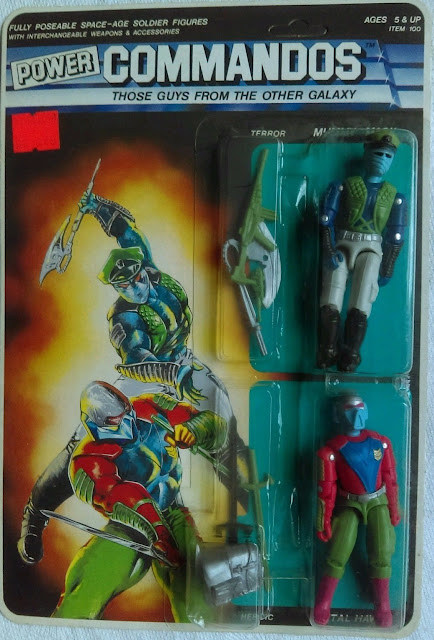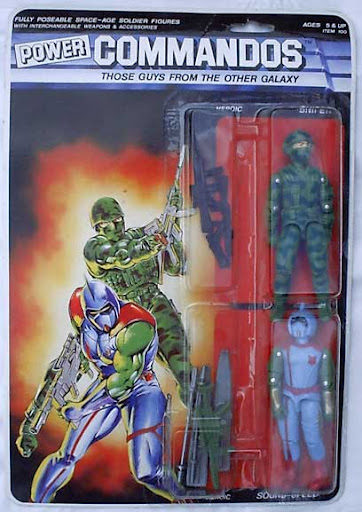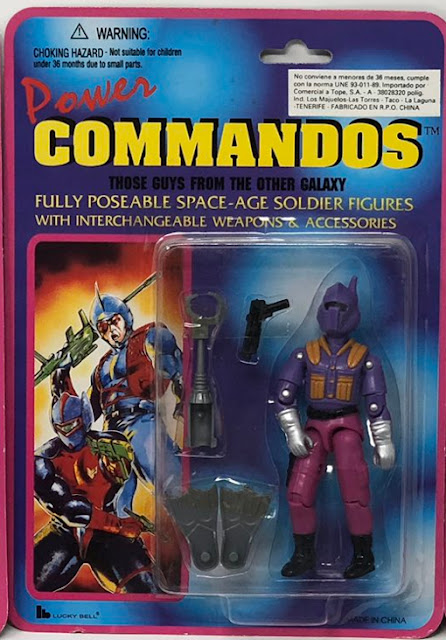I've looked at Power Commandos several times in various Rarities Months. And, in that time, I've learned a great deal about these figures, how they were released and a general timeline of the various series. Through discussions in the comments in the past couple of years, it became apparent that there is a different release cadence for the Power Commandos than I had previously published. What I thought was the first Wave of figures is more likely the second wave. And, the second is actually the first. Plus, I have some new info on the ultra rare third wave. And, then, the mystery of the origin of these figures deepens, again. As, the molds show up on an obscure line of figures from Argentina that no one would know about aside from the fact that they were packed with overstock Comandos Heroicos figures from the Plastirama line.
Wave 1 - 12 Figures (1992)
Originally, I thought that the wave of 6 figures was the first wave of Power Commandos. It was marked 1992 and has no mention of the other 6 molds that are part of the series. However, what I had thought was the 2nd wave is more likely to have actually been the first. Confused? Yeah, me too.
Below is the cardback from a wave of 12 Power Commandos set. You'll notice that all 12 figures are shown. And, the six figures that are the most common molds are actually shown in their alternate paint schemes.
This is where it gets confusing.
Below are two carded samples from this wave of 12. You will note that each of the figures was both available in a different paint scheme in the series of 6, but also that their paint scheme on this cardback actually matches the card art. Mummy Mask has dark blue sleeves and Metal Hawk has green pants. You'll even note that the green accessories match up with the green color shown the card art.
Wave 2 - 6 figures (1992)
It is likely that the 6 repainted figures that are most known to collectors are actually a second wave of repaints. This series tends to have the black weapons. But, more importantly, each of the 6 figures is repainted and they no longer match their card artwork. (This is especially notable on Condor Strike as the character in this wave features a different chest construction than the one in the original wave. The card art still shows his original chest.) As the packaging wasn't really changed aside from some minor cosmetic details, it's possible that the 1992 date on these figures was a carry over from the 1st wave. That would help explain the odd gap with 18 figures being released in 1992 and the final 6 not appearing until 1995. If these repaints were actually released in 1993 or 1994, the gap in production timeline is better explained.
Wave 3 - 6 Neon Figures
The Wave 3 figures feature a 1995 date on the cardbacks. These figures were sold on single cards. There were 6 figures in the set. The fact that the six figures included happen to match up to the 6 who were excluded from the Wave 2 repaint set is both awfully convenient and also sensical. You will note, though, that many of the figures feature construction changes from their Wave 1 appearance. Some info indicates that the 6 molds from the 1st wave that weren't carried over to the 2nd wave was due to lost or damaged molds. It's possible that the parts changes on these figures versus their original use was due to the mold issues.
Argentina Johny Quest - Single Figure
So, here's where it gets even weirder. G.I. Joe collectors have long known about the figures released by Plastirama in Argentina. Tons of overstock came to the US in 1999-2000 and was widely available. Among these finds were these oddball Johny Quest two figure packs. Each included a Johny figure as well as a random Plastirama G.I. Joe figure. The packaging is similar to that used by Galoob for the US release of Johnny Quest figures. But, the Johny figure is different. This one uses parts from the Power Commandos. The Johny figures all appear to be the same. But, the appearance of Lucky Bell parts is odd and doesn't make much sense unless an Argentine toy company imported Johny figures from China and then paired them with Comandos Heroicos figures that were made in Argentina.
So, what do we know? Not much. We know there are 24 unique figures produced with these molds under the Lucky Bell name. Then, there is the oddball Johny Quest figure. It's very possible that the molds could have been used in other obscure lines in South America or Asia and collectors will never find them as they have no real connection to G.I. Joe or the Power Commandos. But, the overall story of how these figures came to be is likely lost to time.
But, the fact that so many molds were created and that the both the figures and packaging were high quality indicates that someone spent some money to produce these figures. The first wave was heavily sold in the US at discount and liquidator type stores. The second wave overstock has mostly been traced to South American and Mexico. Though, the packaging indicates that this surplus was originally intended for sale in the US. The 3rd wave's overall rarity makes it difficult to pin down. The appearance of the mold on the Argentina release shows that these molds were there for other uses if someone wanted to spend the money to make some toys. But, how they found their way to match up with Jhony Quest and the G.I. Joe overstock will likely remain a mystery.







.jpg)












Maybe they borrowed some molds from LB, who knows? These don't look legit to me, almost like a shoddy bootleg. The figures don't match the figure tray, and they seem to be missing accessories meant for the US versions. The one with Destro looks particularly awkward, it just screams "FAKE!" i wouldn't mind owning that Johnny Quest figure, he would be my radical skater dude archetype.
ReplyDeleteThe US Jonny Quest figures were smaller than 3 3/4". So, it appears they kept the same packaging with smaller bubbles from the Galoob, US line and squished in the overstock Joes into them.
DeleteI have owned the Plastirama / Jhony Quest Ripcord / Soldado De Asalto, and hunted for Joes in ARG. Trust me, there are no other hidden 3 3/4" lines using the molds down there. There are still plenty of Joe collectors there (and many more MOTU!), and they would have found them all by now. We are living in a highly connected world now.
ReplyDeleteAnother super weird/awesome "Jhony Ques" figure utilizing Lucky Bell Power Commando parts has been discovered. This was acquired from a seller who got it in a lot mixed in with other random G.I. Joe and Jonny Quest figures.
ReplyDelete[img]https://videofileblog.com/wp-content/uploads/2024/07/jhony-ques.jpg[/img]
https://videofileblog.com/wp-content/uploads/2024/07/jhony-ques.jpg
DeleteThat's just nuts. These molds just keep on giving.
DeleteAn eBay auction for a Jhony Ques 2-pack with the skater figure has a pretty good look at the packaging, which does not appear to have any Plastirama or other toy company logos anywhere on it. I always assumed these were bootlegs, and it still feels that way to me. Though if true, they seem to have put a surprising amount of effort into repainting the Lucky Bell parts and sculpting new heads for the o-ring JQ figures.
Deletehttps://www.ebay.com/itm/285838384469
You couldn't give away those Jhony Quest items back when they first surfaced. It's both amazing and, kind of appalling, to see just how much Plastirama stuff has skyrocketed in price.
Delete